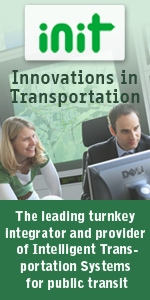

| In This Issue |
| » BREAKING NEWS |
| » NEWS HEADLINES |
| » IN DEPTH: TECHNOLOGY |
| » APTA NEWS |
| » TELLING OUR STORY |
| » COMMENTARY |
| » PEOPLE ON THE MOVE |

Check out the classifieds for numerous transit career opportunities including a chief executive officer!
| IN DEPTH: TECHNOLOGY |
Keeping Up with Transit Communications Technologies
BY DAVE GORSHKOV, Chief Executive Officer, Digital Grape Business Services Ltd., Lovedean, Hants, U.K., and Chair, APTA Communications Subcommittee
The use of advanced technologies is moving at such a pace these days that “transport proven” credentials are often hard to come by—because, no sooner does a technology becomes transport proven, it is out of date! This dynamic emphasizes the need for the work of the APTA Communications Subcommittee’s Technical Standards Working Group (TSWG1) in reviewing various types of technology for use in all aspects of public transport.
Closed Circuit TeleVision (CCTV) is one such technology, which is becoming increasingly popular for public transit agencies. For example, Valley Metro Rail in Phoenix and Sound Transit in Seattle operate advanced light rail vehicles (LRVs) with multi-camera installations in each car. These cameras cover 360 degrees of the outside of the car—essential these days for use in city streets—as well as all interior areas. Buses are also bristling with cameras these days, as can be demonstrated by any number of times we see transit-related incidents on reality TV!
TSWG1 has spent three years developing a new recommended practice for the use of CCTV and video analytics in transit applications. Why? Because, with all the various facets connected to CCTV, the time to find out you don’t have the right specification camera or recorder setup is not when you have just had a major incident or are faced with an insurance claim you can’t defend!
Why to Install CCTV
Understanding why you are installing CCTV is the step you should take before you issue your requirements document. To take but one example, the system you see working in a local convenience store, designed for commercial use, will most definitely not work for very long in a transit installation.
Typical payback justifications, or returns on investment (ROIs), for CCTV systems include lowered insurance costs through reduced premiums (evidence of slips and falls, vehicle impacts), a safety system to help transit staff in the event of assault (video evidence of any potential assailant), and the deterrent effect for various types of transit crime (vandalism, tagging, farebox protection).
The document pulled together by TSWG1 contains technical information and recommended minimum requirements to help operators identify their needs while they also arm themselves with a baseline specification of a system that can be used either in court or with an insurance company. The committee consists of operators, consultants, and vendors, so a number of interesting discussions around the table have ensued when we examined aspects of reordering durations, camera resolution, frame rates, and compression systems.
“But I run a bus operation—I don’t need CCTV,” I hear you say. Well, the system for bus or paratransit need not be as robust as that fitted to a commuter, heavy, or light rail vehicle, but you will still need to understand what it means to record at certain resolutions and frame rates; why it is important to have a minimum standard for cameras; and how to handle recordings in the event of an incident. Our document also provides information on maintenance routines and acceptance testing methods.
If your CCTV design already meets these requirements, then you are in great shape. If not, you might want to look at the document the next time you plan to procure a system.
What about rail systems? Well, whilst a bus operation can use a system designed for a rail vehicle, rail vehicles must ensure that they use “rail hardened” equipment. And let’s not even discuss floating power supplies that must be fitted to rail systems, as well as extra robust hard drives and high data rate train lines!
Wayside installations, depots, stations, and other transit buildings such as parking garages are also included in the document, with recommendations for the various areas you will have and need to protect. It also covers cash rooms, perimeters, garage areas, bus stops, platforms, and tunnel protection.
So, what else has the committee been up to? As we move into 2010, we are developing additional information for the latest generation of IP-based cameras, video analytics, and the next generation of network recorders and information on wireless links that can and cannot be used with CCTV.
But our effort goes beyond CCTV. We have been working toward a cyber security standard and are now looking at how technology can be used in the area of Intelligent Transportation Systems that is of increasing potential benefit to transit operators, including those with Global Positioning Satellite-based Automatic Vehicle Location systems.
So let me take this opportunity to welcome you to our next TSWG1 or communications subcommittee meeting. We are always looking for input on applications and scenarios we can include in our work!
| « Previous Article | Return to Top | Return to Main | Next Article » |
|
||||||
| AMERICAN PUBLIC TRANSPORTATION ASSOCIATION |
Telephone (202) 496-4800 • Fax (202) 496-4321
Search Back Issues